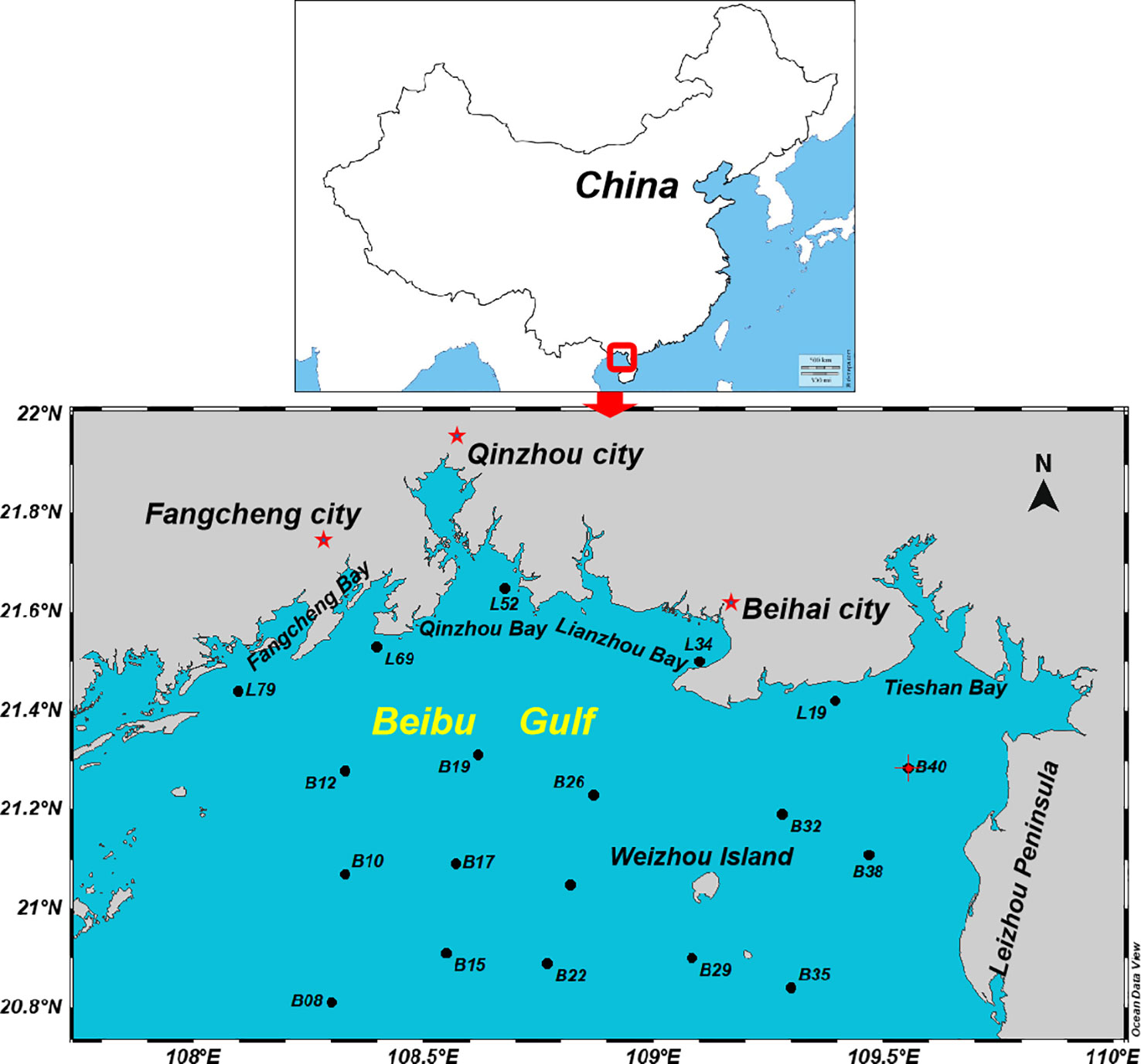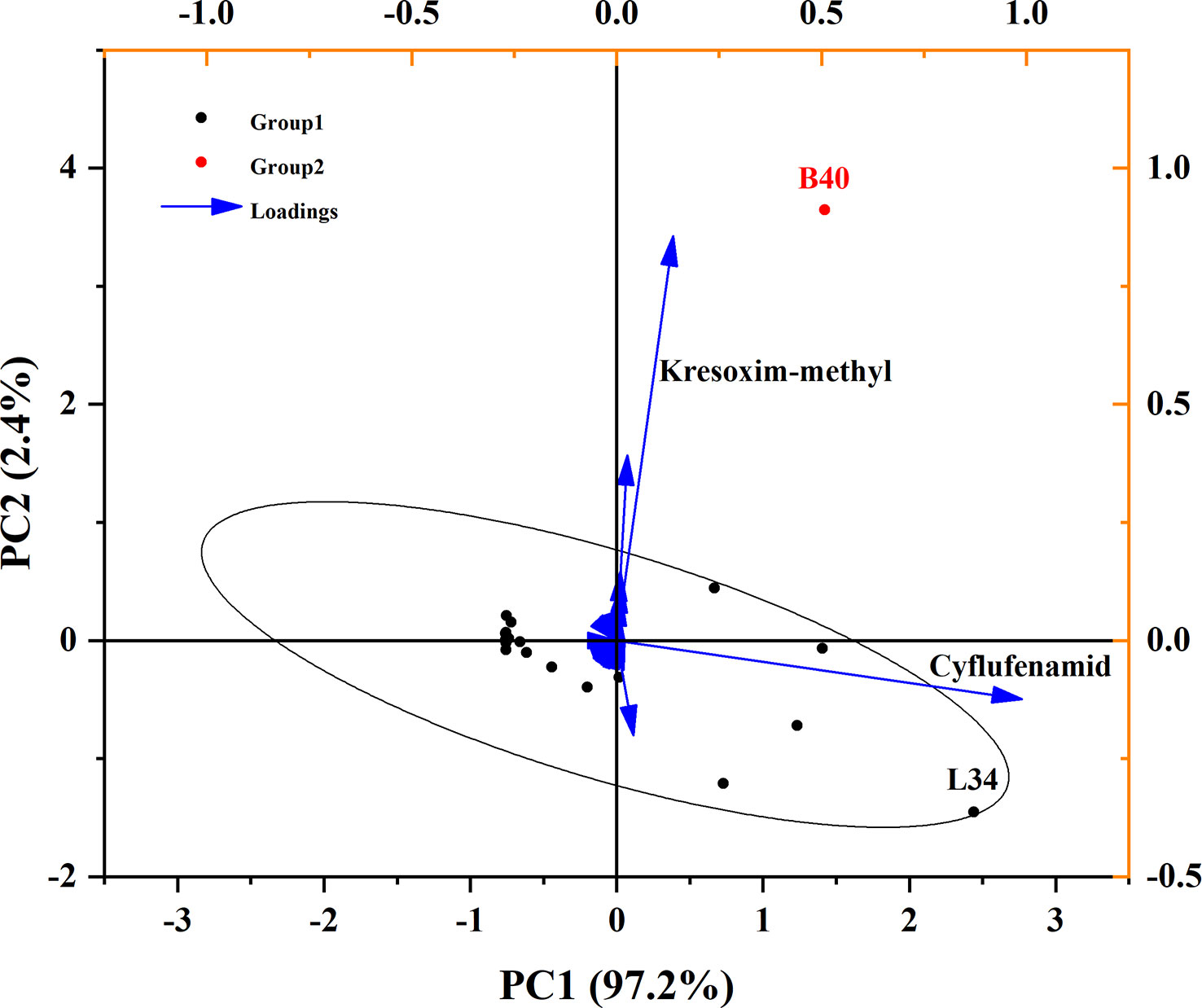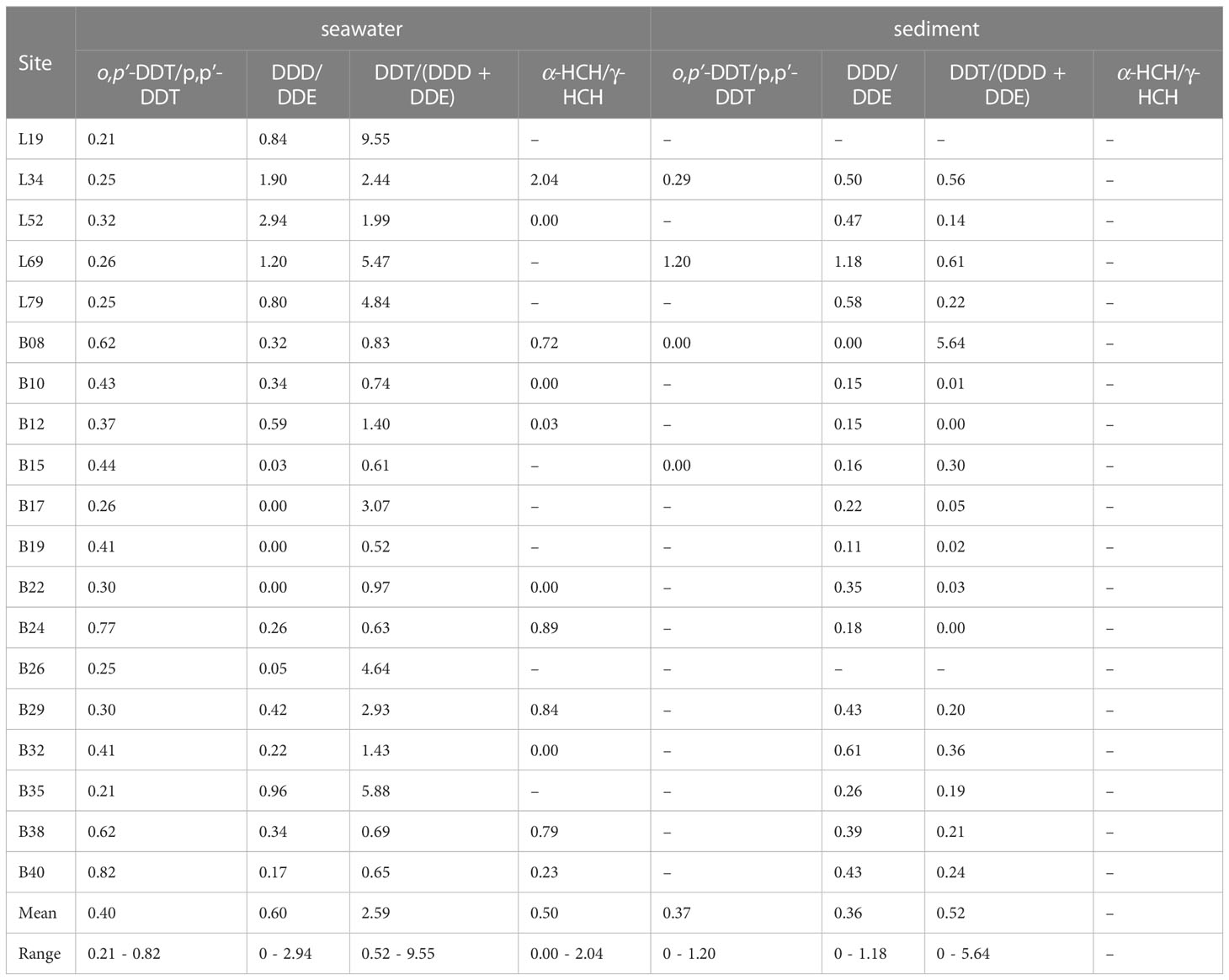- 1Guangxi Key Laboratory of Beibu Gulf Marine Resources, Environment and Sustainable Development, Fourth Institute of Oceanography, Ministry of Natural Resources, Beihai, China
- 2Key Laboratory of Marine Ecological Monitoring and Restoration Technologies, Ministry of Natural Resources, Shanghai, China
- 3Key Laboratory of Marine Ecosystem Dynamics, Second Institute of Oceanography, Ministry of Natural Resources, Hangzhou, China
- 4School of Environmental Studies, China University of Geosciences, Wuhan, China
- 5Ministry of Natural Resources Key Laboratory for Polar Science, Polar Research Institute of China, Shanghai, China
With the prohibition of conventional organochlorine pesticides (OCPs), the extensive use and continuous release of current-use pesticides (CUPs), such as organic amine pesticides (OAPs) and organophosphate pesticides (OPPs), in agriculture and mariculture activities have raised global attention. In this study, the occurrence and distribution of 36 pesticides from above 3 categories were investigated in seawater and sediment in Beibu Gulf, a typical subtropical agricultural and maricultrual zone. Results showed that pesticides were widely present in this region with the total concentration ranging from 0.36 to 21.07 ng/L in seawater and from 0.02 to 9.73 ng/g dw in sediment. OAPs and OPPs were the most abundant categories contributing 74% and 66% to the total pesticides burden in seawater and sediment, respectively, revealing the current-use pesticides as substitutes of legacy organochlorine pesticides (OCPs) were mainly used in surrounding areas. For both seawater and surface sediment, the spatial distribution of pesticides concentrations showed generally seaward decreasing trends, suggesting that anthropogenic activities at coastal areas have an important impact on pesticides pollution. Source identification indicated OCPs in some seawater samples might be from mixture of antifouling paint and dicofol usage, while history residues are main sources of OCPs in sediment. OAPs, especially for cyflufenamid and kresoxim-methyl, mainly come from agricultral and maricultural sewage input, and OPPs were speculated from currency transportation from surrounding areas. Ecological risk assessment showed that OPPs posed moderate to even high risks in most seawater sites. It appears that crustaceans are the most sensitive trophic species to OPPs among aquatic organisms, followed by fish. According to the results of health risks proposed by the major aquatic products in Beibu Gulf (fish and shrimp), the selected pesticides pose no health risk to humans. Nevertheless, OCPs made the highest contribution to the total HQ values. Comprehensively considering the evaluation results of both ecological and health risks, more attention should be given on OPPs and OCPs pollution in the Beibu Gulf.
1 Introduction
Pesticides have been widely produced since the 1940s and used in agriculture, mariculture, and landscape maintenance to kill weeds and insects and sterilize the area (Wang et al., 2022a; Zhang et al., 2021b; Zhang et al., 2022). However, pesticides are intentionally toxic, often towards non-target organisms, and their intentional release into the environment has serious environmental consequences (Van Dyk and Pletschke, 2011). Owing to their long persistence, high bioaccumulation, and toxicity to organisms and human beings, conventional organochlorine pesticides (OCPs), such as dichlorodiphenyltrichloroethane (DDT) and hexachlorocyclohexane (HCH), have been widely banned or restricted since the 1970s. In contrast, current-use pesticides (CUPs), such as organophosphate pesticides (OPPs) and organic amine pesticides (OAPs), have been continuously launched into the market and are intensively used as alternatives to OCPs (Wang et al., 2021). In China, OPPs accounted for 80% of the total pesticide usage in 2010, according to the China Statistical Yearbook (Xiao et al., 2021). Additionally, fresh DDT is still released into the environment because of dicofol production, and there are some special applications of DDT in antifouling paints in some developing countries, including China (Peng et al., 2020).
Coastal areas have been considered important sinks for many pollutants (Zhang et al., 2021a). During the pesticide usage cycle, approximately 60% of pesticides diffuse into the air or drip into the soil, and ultimately ending up in marine environments by way of surface runoff or precipitation (Wang et al., 2022b). Moreover, pesticides have been widely used in mariculture to improve the health of organisms (like tilapia, catfish and penaeid shrimps) and localized environmental conditions, causing direct pesticide pollution in coastal ecosystems (Rico et al., 2012). For example, OCPs residues (0.59~126 ng/g for DDTs, n.d.~2.65 ng/g for HCHs and 0.27~3.41 ng/g for chlordanes in sediments) are widely found in the Qinzhou Bay, a semi-closed bay with intensive aquaculture activities (Xu et al., 2013). And total DDT concentrations also were higher in the farm-raised fish compared to the wild-caught fish (30.5 versus 5.4 ng/g) (Sapkota et al., 2008; Xu et al., 2013). Notable amounts of OCPs residues are discharged into coastal areas owing to intensive aquaculture activities, ambient wastewater discharge, and runoff from farming (Sapkota et al., 2008; Xu et al., 2013). However, questions regarding the occurrence, distribution, and ecological risks of CUPs in aquatic environments, especially in different marine media, remain largely unexplored in China (Grung et al., 2015; Zheng et al., 2016). Additionally, the difference between CUPs and traditional OCPs concentrations in the environment remains unclear.
Although most CUPs are less persistent than conventional OCPs in aquatic environments, their extensive use and continuous release may result in pseudo-persistence and appreciable pesticide exposure by aquatic organisms (Wang et al., 2021). For example, OPPs and carbamate pesticides can cause endocrine disruption and neurological disorders in mammals, birds, and fish (Van Dyk and Pletschke, 2011). Furthermore, considering the mixed use of multiple pesticides in actual production and living activities, pesticides in aqueous environments may have synergistic effects, which may increase their ecological toxicity, even at low concentrations (Laetz et al., 2009). Therefore, it is crucial to comprehensively study the pollution characteristics of multiclass pesticides in coastal environments and assess their potential impacts on ocean ecosystems.
The Beibu Gulf is located in the northwest of the South China Sea and is bounded by Guangxi Province in the north (Zhang et al., 2021a). The subtropical marine climate and abundant nutrients brought by seagoing rivers make the Beibu Gulf one of the most important natural fishing and mariculture zones in China. Agriculture is predominant in Guangxi Province, and it is dominated by grain, sugarcane, vegetables, and fruits. Agriculture and aquaculture production systems are characterized by the intensive spesticides usage, which inevitably leads to pesticide input into the Beibu Gulf. On the contrary, studies on current circulation in the Beibu Gulf revealed that the Qiongzhou Strait current was westward year-round (except for a few days in summer) (Gao et al., 2017); thus, it too may introduce pollutants into the Beibu Gulf from surrounding areas. To date, however, only a few studies have investigated OCPs in sediment in the Beibu Gulf (Xu et al., 2013; Tang et al., 2020). For example, Xu et al. (2013) reported OCPs concentrations ranging 0.59~126 ng/g for DDTs, n.d.~2.65 ng/g for HCHs and 0.27~3.41 ng/g for chlordanes in sediment Kaiser et al. (2016) found DDT concentrations ranging 0.2~41.0 ng/g and HCB ranging 0.01~1.01 ng/g in surface sediment of mangroves from the Beibu Gulf. As for the CUPs, total concentration of OPPs ranging 0.775~3.09 ng/L of OPPs were reported in the seawater in the East China Sea (Xiao et al., 2021), and concentration of 17 CUPs in surface seawater samples ranging from 9.5 to 267.3 ng/L was found in the Yellow Sea and East China Sea (Wang et al., 2022b), while no information is available on CUPs pollution.
Solid-phase extraction (SPE) has been widely used for the extraction and concentration of trace organic pollutants. Compared with SPE, high-volume solid-phase extraction (Hi-volume SPE), as described previously (Xiao et al., 2021), has the advantages of larger sampling volumes, shorter filtering times, and lower method detection limits; therefore, it has been applied to the analysis of organophosphate esters (Zhang et al., 2020b), fluoroalkyl substances (Shan et al., 2021), and pesticides (Xiao et al., 2021) in aquatic environments. In this study, the Hi-volume SPE method was used for the collection of 36 pesticides, including 14 OCPs, 16 OPPs and 6 OAPs, in seawater samples from the Beibu Gulf. The residues, potential sources, and ecological risks of multiclass pesticides in both seawater and sediment were explored.
The objectives of the present study were to (1) determine the occurrence of legacy OCPs and current-use OPPs and OAPs in both seawater and surface sediment in the Beibu Gulf, (2) investigate their distribution patterns and related impact factors, (3) explore the potential sources of these pesticides, and (4) assess the ecological risks and the health risks posed by pesticides to aquatic organisms and humans in the Beibu Gulf.
2 Materials and methods
2.1 Study area
The Beibu Gulf is surrounded by the Leizhou Peninsula, Qiongzhou Strait, Hainan Island, Vietnam, and the Guangxi Province. It covers an area of 1.3 × 105 km2 and is a typical semi-closed gulf with an average depth of approximately 38 m (Zhang et al., 2020). The climate around the gulf is subtropical and monsoonal (Chen et al., 2009). The Beibu Gulf has abundant bays and seagoing rivers. Environmental and climatic advantages make the Beibu Gulf one of the four largest fishing bases in China. Moreover, its wide shallow sea and mudflats make it suitable for the breeding and growth of multiple marine organisms. In 2015, the production of marine aquaculture and open water fishing yielded 1.8 million tonnes in Guangxi province (The Oceanic Administration of Guangxi, 2017). Moreover, planting has been an important part of Guangxi’s agricultural industry, accounting for 51.1% in 2016, and the crop planting area reached 7204,100 ha by 2020 (The Statistical Bureau of Guangxi, 2020). In particular, fruit production in Guangxi is among the highest in the country. Intensive agricultural and aquaculture activities have been identified as the main sources of pesticide pollution in coastal areas (Zhang et al., 2021b).
2.2 Sample collection
Surface seawater and sediment samples were collected from 19 sites in the Beibu Gulf in May 2021 (Table S1 and Figure 1). Samples were mainly collected from fishing wharfs or mariculture areas (L34, L69, L79, B29, B32), industrial or harbor areas (L52), scenic (L19), and agriculture areas (B40 and B38). Meanwhile, sites with different offshore distances were set on each section, such as L69, B12, B10 and B08, to compare the spatial distribution of pesticides. Water samples were collected and stored in a pre-cleaned amber glass bottle at 4°C and then processed within 12 h. Surface sediment (0–5 cm) was collected using a stainless-steel grab sampler. The sediment samples were freeze-dried, and then the sediments were ground and sieved (80 mesh per inch), after which all samples were stored at -20°C in the dark prior to chemical analysis.
2.3 Sample pretreatment
Sample extraction and cleanup were performed as previously described (Xiao et al., 2021; Zhang et al., 2022). Seawater samples (8 L each) were pumped using a peristaltic pump through a Hi-throat/Hi-volume SPE sampler at 0.36 L min−1, where particulate phases were separated and retained on a filter (Whatman GF/F; 0.7 μm pore size; 142 mm diameter), and the dissolved pesticides were loaded onto the adsorption column. Before extraction, the Hi-volume SPE adsorption column was freeze-dried and spiked with heptachlor-exo-epoxide (100 µL, 1 mg/L) as internal standard. The target compounds were eluted three times, each time by the addition of 30 mL of DCM to the adsorption column in the stainless-steel casing tube, which was then sealed in an aluminium foil bag and oscillated for 3 min. Each eluate was collected in a glass bottle after it had been passed through a silica gel purification cartridge (ANPEL Laboratory Technologies, Shanghai, China) for purification. The extracts were then combined and concentrated to 0.5 mL at room temperature, after which 10 mL n-hexane was added. The extracts were then re-concentrated, adjusted to a final volume of 1 mL using hexane, and stored at -20°C until analysis. More details on the seawater sample treatments can be found in our previous reports (Xiao et al., 2021; Zhang et al., 2022).
The extraction of multi-class pesticides from sediments was performed using ultrasonic-assisted extraction. Twelve grams of homogenized sediment were added to a 100 mL glass jar and spiked with heptachlor-exo-epoxide (100 µL, 1 mg/L) as the internal standard. Subsequently, 25 mL dichloromethane solution was added and ultrasonic-assisted extraction was performed for 30 min, followed by centrifugation at room temperature for 10 min at 3500 rpm thrice. The combined supernatant was passed through a silica stainless steel column for purification and then transferred to a 200 mL nitrogen-blow tube. Thereafter, the same process as that of the water samples was applied. The total organic carbon (TOC) in the sediment were measured by quantifying CO2 using a TOC Analyzer (Vario TOC cube, Elementar, Germany). And related values were listed in Table S1. The oil content in the seawater was measured using ultraviolet spectrophotometry (UH5700, HITACHI, Japan).
2.4 Chemicals and standards
In total, 36 pesticides, including 14 OCPs (dichlobenil, α-Hexachlorocyclohexane, β-Hexachlorocyclohexane, γ-Hexachlorocyclohexane, hexachlorobenze, o,p’-dichlorodiphenyltrichloroethane (o,p’-DDT), o,p’-dichlorodiphenyldichloroethylene (o,p’-DDE), p,p’-dichlorodiphenyldichloroethylene (p,p’-DDE), p,p’-dichlorodiphenyldichloroethane (p,p’-DDD), p,p’-dichlorodiphenyltrichloroethane (p,p’-DDT), chlorfenson, clomazone, β-Endosulfan), 16 OPPs (methacrifos, phorate, dichlofenthion, fenchlorphos, bromophos, isofenphos-methyl, bromophos-ethyl, ditalimfos, isofenphos-oxon, chlorthiophos, terbufos, diazinon, chlorpyrifos, parathion methyl, malathion, parathion), 6 OAPs (profluralin, triallate, pentachloroaniline, vinclozolin, cyflufenamid, kresoxim-methyl) and heptachlor-exo epoxide were analyzed in this study. Chemical standards were purchased from Sigma-Aldrich (Steinheim, Germany) and Dr.Ehrenstorfer (Augsburg, Germany) with purity ≥95%. HPLC-grade solvents, including n-hexane and dichloromethane were purchased from J.T. Baker (USA), and ultrapure water from a Milli-Q unit (Millipore, USA) were used for all analyses. Individual stock standard solution (1000 μg/mL) of each pesticide was prepared in methanol and kept at -20 °C. Calibration curves for mixture of all pesticides were prepared in methanol ranging from 2 ng/ml~500 ng/ml (heptachlor-exo epoxide 100 ng/ml) and were used to quantify the target pesticides in both seawater and sediment.
2.5 Instrumental analysis
Before extraction, the Hi-volume SPE adsorption column was freeze-dried and spiked with heptachlor-exo-epoxide (100 µL, 1 mg/L) as surrogate and internal standard. Gas chromatography-tandem mass spectrometry (GC-MS/MS) analysis was performed using an Agilent 8890 gas chromatograph coupled to a 7010 B mass spectrometer (Agilent Technologies, Santa Clara, California, USA) equipped with an electron impact ion source. Chromatographic separation was performed in an HP-5ms GC column (30 m × 0.25 mm, 0.25 µm, Agilent Technologies). Helium was used as the carrier gas, with a column flow rate of 1.2 mL/min. The oven temperature program was initially set at 40°C for 1 min and then ramped at 40°C/min to 120°C, then 5°C/min to 240°C, and then 12°C/min to 300°C for 6 min. Injection of 1 μL of the sample was performed using the splitless mode, and the injector temperature was set to 280°C. The temperatures of the interface, ion source, and quadruple were 290°C, 230°C, and 150°C, respectively. The retention time as well as the selected quantifier ions obtained under the above GC-MS/MS conditions are presented in Table S3.
2.6 Quality assurance and quality control
To avoid potential contamination, all glassware was heated at 450°C for 2 h in a muffle furnace to volatilize any organic substances before use. For every 10 samples, a blank sample and spiked blank sample (100 ng of mixed pesticide standard) were included to assess the repeatability of the method. The limit of quantification (LOQ) was defined as ten times the signal-to-noise ratio for compounds not detected in the blank samples; for other pesticides, the LOQ was defined as the mean value of the target compound detected in the blanks plus thrice the standard deviation. The LOQs of all pesticides ranged from 0.0003–0.27 ng/L in water samples and from 0.0008–0.0082 ng/g dw in sediment samples (Table S4). The recoveries of method was calculated by spiking the pesticides mixture (100 µL, 1 mg/L) in MilliQ water and blank sediment samples, respectively. The recoveries of target pesticides ranged 50–135% and 53–135% for seawater and sediment samples, respectively (Table S4). And the recoveries of the heptachlor epoxide in most seawater and sediment samples ranged 51–94% and 51–82%, respectively.
2.7 Risk assessment
2.7.1 Ecological risk
The ecological risks of the target pesticides in the surface seawater and sediment of the Beibu Gulf were assessed with the risk quotient (RQ) (1):
where MEC is the maximum measured environmental concentration (ng/L); PNEC is the predicted no effect concentration in seawater (ng/L) (Zhang et al., 2021a).
PNEC of sediment is derived by equilibrium partitioning between water and sediment, calculated with (2) (European Commission, 2011):
where foc is the dimensionless organic carbon fraction of sediment, and Koc is the partition coefficient between organic carbon-water (L/kg), and PENCaqua is calculated by the toxicological relevant concentration (LC50/EC50) and assessment factor (AF):
50% lethal/effect concentration (LC50/EC50) was used as toxic endpoints considering present study, while an assessment factor of 1000 was used (European Commission, 2011; Chen et al., 2019).
0.01 ≤RQ< 0.1 indicates low risk or potential adverse effect; 0.1 ≤ RQ< 1 indicates moderate risk or adverse effect; and RQ ≥ 1 indicates the risk of the compound is high and attention should be paid.
2.7.2 Health risk
Since humans cannot directly ingest seawater, the health risk of selected pesticides to humans was estimated from the intake of fish and shrimps in the Beibu Gulf. A bio-concentration factor (BCF) model was used to predict the concentrations of selected pesticides in fish and shrimps, as equation (4) (Arnot and Gobas, 2006; Xiao et al., 2021):
where Cw is the concentration of the pesticides in the seawater (ng/L) and Cp is the concentration of the pesticides in the predator (ng/kg). The value of BCF (L/kg) was taken from US EPA ECOTOX database (http://www.epa.gov/ecotox). The average daily doses (ADDs; ng/kg/day) of pesticides were estimated as our previous study (Xiao et al., 2021), as equation (5):
where IR is the daily ingestion rate of fish and shrimps, the main seafood of the Beibu Gulf, for a specific age group (group with age>18 was selected representing the main consumption group in this study). The daily seafood ingestion rate for fish (59.3 g/day) and shrimp (6.05 g/day) in the study were obtained from a questionnaire-based dietary survey in the coastal areas of South China (Guo et al., 2010); AP is the percentage absorption of intake, which was assumed to be 100%; and BW is bodyweight, which was set at 60 kg based on other research (Luo et al., 2009). The sum of the ADDs of OCPs, OPPs and OAPs was considered the ADD of all three groups of pesticides.
The health risks of selected pesticides in the Beibu Gulf were assessed with the hazard quotient (HQ) method as our previous reports:
where RfD is the reference dose value of each pesticide (ng/kg/day). The RfDs were obtained from the EPA Regional Screening Level (RSL) Summary Table. The sum of the individual HQs of all the OCPs, OPPs and OAPs was considered as the total HQ of selected pesticides. We considered that a health risk existed at HQ > 1. The health risks of selected pesticides in the Beibu Gulf were assessed with the HQ method as our previous reports (Xiao et al., 2021).
2.8 Statistical analysis and graphing
The chromatographic data were analyzed by an Agilent MSD ChemStation. Statistical analysis was performed with the IBM® SPSS® Statistics 26 (Pearson’s correlation analysis) and Origin® 8.5. Statistical significance was accepted at 95% confidence (p< 0.05) throughout the present study. The sampling sites and concentration distribution graphs were generated by Ocean Data View (version: 5.3.0, Sclitzer, Reiner, Ocean Data View, https://odv.awi.de, 2020).
3 Results and discussion
3.1 Occurrence and concentrations of pesticides in surface seawater
The occurrence and concentrations of OCPs, OPPs, and OAPs in seawater and sediment samples are provided in Table 1, Figures 2 and 3, respectively, and the composition of the concentration percentage for individual pesticides is shown in Figure 4. Overall, the total concentration of pesticides ranged from 0.36–21.07 ng/L in seawater, among which OAPs were the most abundant with a median concentration of 0.73 ng/L, followed by OCPs (median 0. 60 ng/L), and OPPs (median 0.36 ng/L).
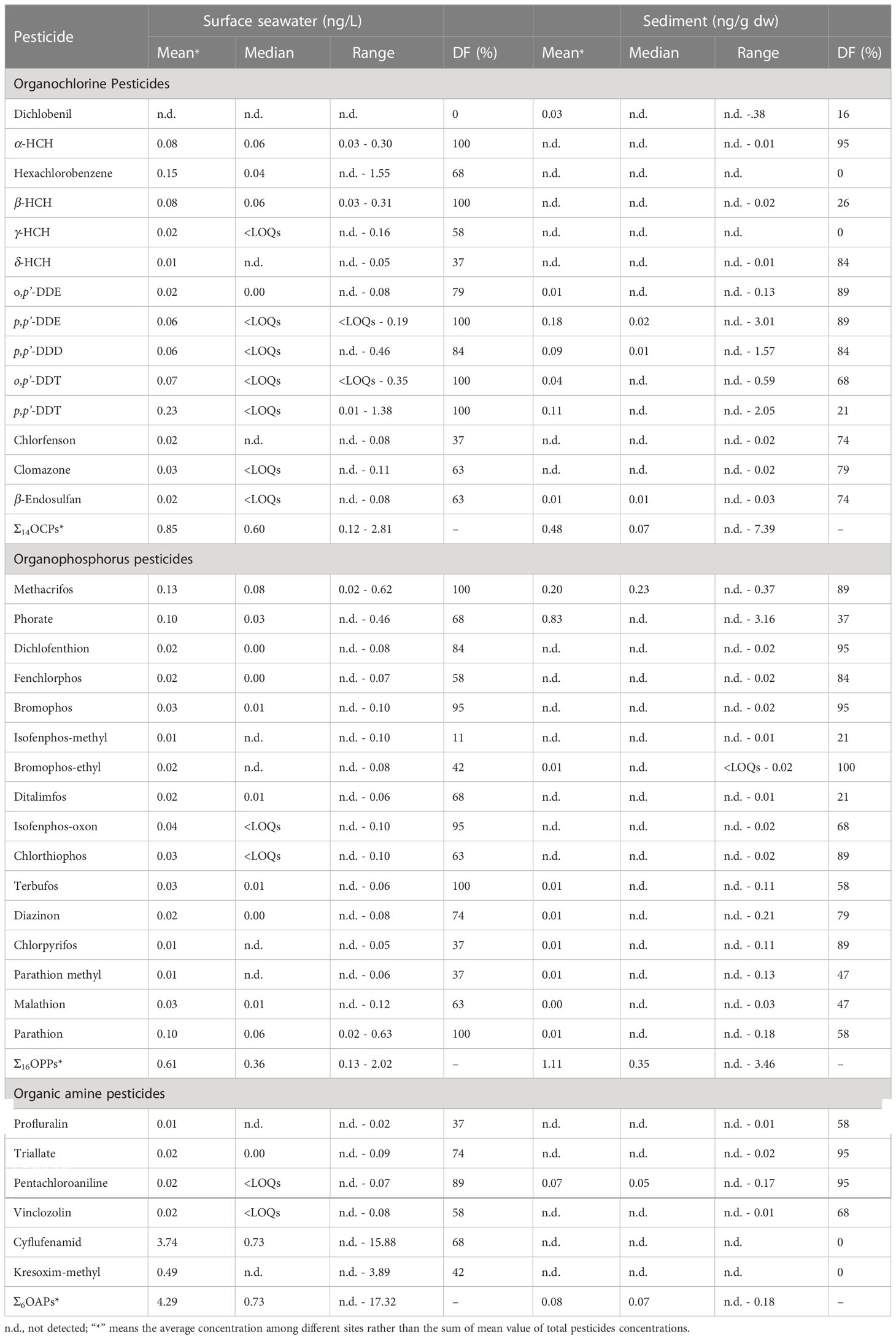
Table 1 Concentrations (mean and range) and detection frequency (DF) of pesticides in surface seawater and sediment of the Beibu Gulf.
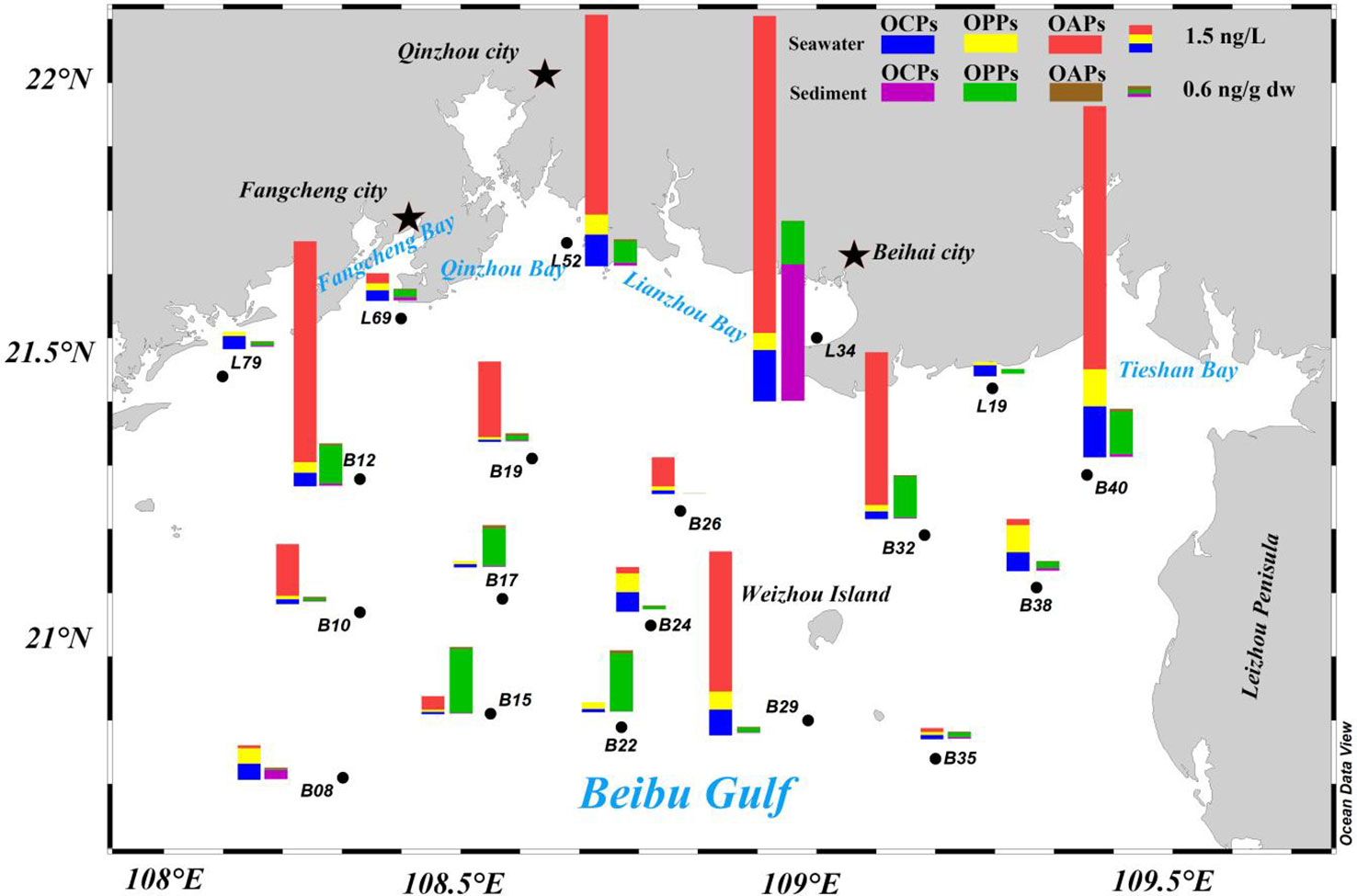
Figure 2 Concentration distributions of organochlorine pesticides (OCPs), organophosphorus pesticides (OPPs) and organic amine pesticides (OAPs) in seawater and surface sediments in Beibu Gulf. The bars represented the mean average cumulative pesticides values in seawater and sediment, respectively.
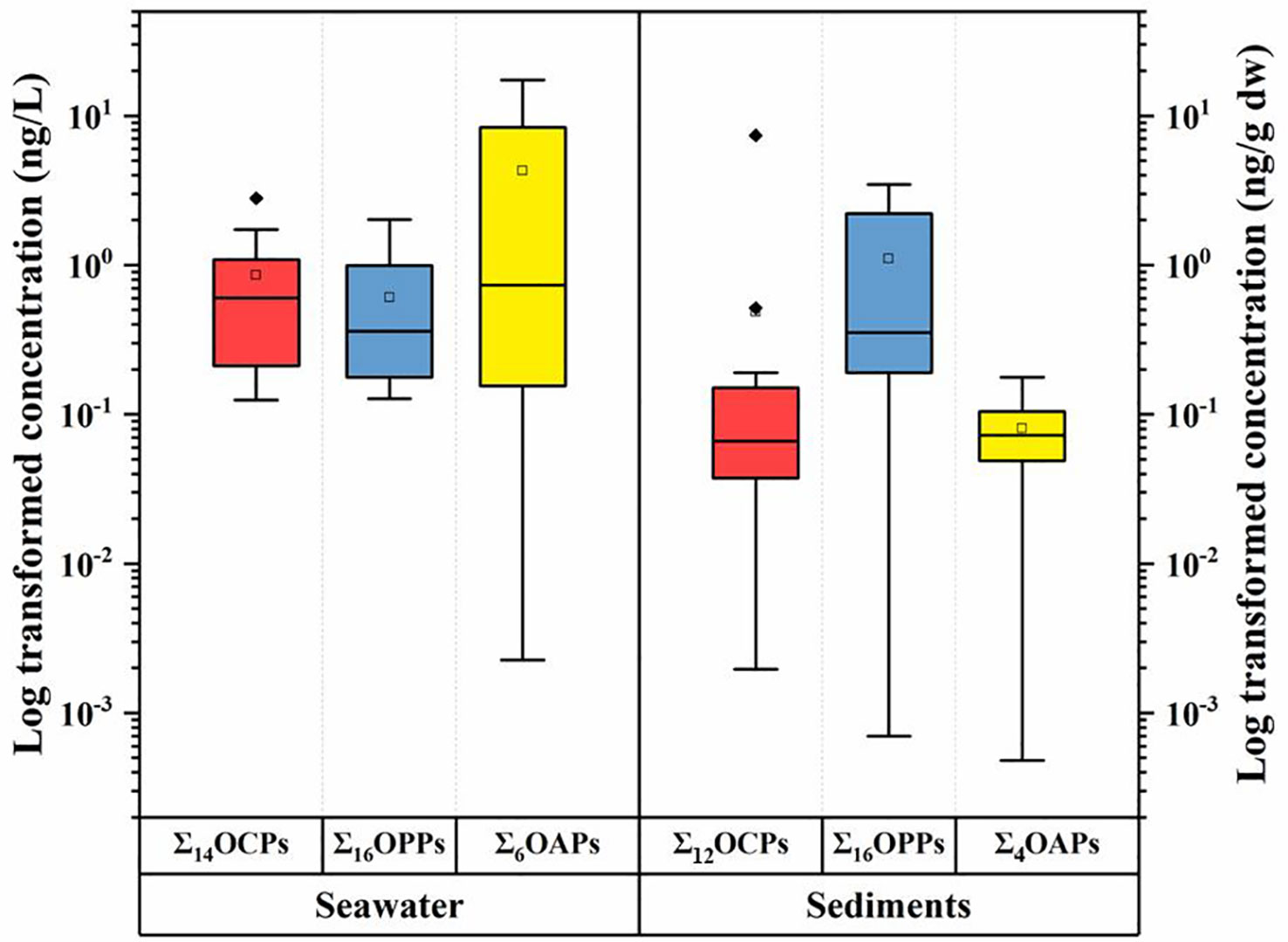
Figure 3 Concentration comparisons of Σ14OCPs, Σ16OPPs, and Σ6OAPs in both seawater and sediment. Σ14OCPs, Σ16OPPs, Σ6OAPs equals to the sum concentration of 14 OCPs, 16 OPPs, and 6 OAPs, respectively. The diamond represents outlier’s value and the square represents mean value.
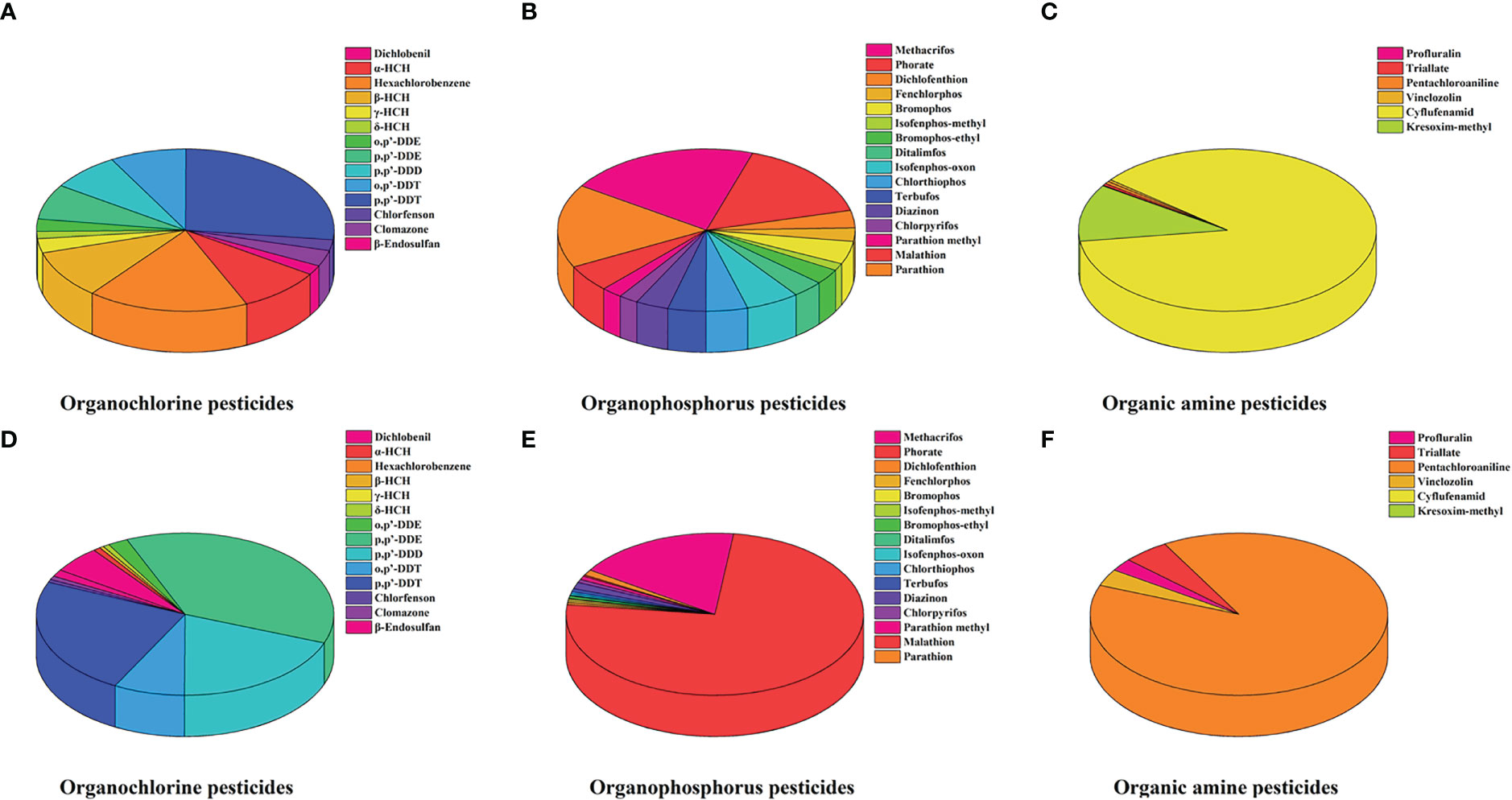
Figure 4 Percentage composition of individual pesticides (A-C) in surface seawater, and (D-F) in sediments.
With the exception of dichlobenil, all OCPs were detected in the seawater samples. The detection frequencies (DFs) of α-HCH, β-HCH, p,p’-DDE, o,p’-DDT, and p,p’-DDT were all 100%, followed by p,p’-DDD, o,p’-DDE, hexachlorobenzene, clomazone, β-Endosulfan, and γ-HCH at >58%, indicating their wide presence in the environment. The total concentration of OCPs (Σ14OCPs) ranged from 0.12–2.81 ng/L in the Beibu Gulf, which was much lower than that in surface water from the industrialized agricultural region of Sinaloa, Mexico (n.d.–65.6 μg/L) (Arellano-Aguilar et al., 2017), areas along the Pampanga River, Philippines (1.02–2.04 μg/L) (Navarrete et al., 2018) and Manyas Lake, Turkey (1.43–8.60 μg/L) (Erkmen et al., 2013). In fact, most OCPs, such as DDT and HCHs, have been banned and/or restricted according to the regulations of different countries for years; however, they persist at considerable levels globally due to their high persistence characteristic both in their original form and stable metabolites, some of which have half-lives of up to 15 years (Navarrete et al., 2018). Additionally, the presence of OCPs in seawater may reflect their current illegal/unintentional usage or their introduction as an industrial impurity.
Hexachlorobenzene and p,p’-DDT were the most predominant OCPs in seawater, accounting for 27% and 18%, respectively, of the Σ14OCPs at all sampling sites. As reported, DDT degrades into 1,1-dichloro-2,2-bis (p-chlorophenyl) ethylene (DDE) and dichlorodiphenyldichloroethane (DDD) in the environment (Baqar et al., 2018; Navarrete et al., 2018); the combined concentration of DDT-derived compounds (ΣDDTs = DDT + DDE + DDD) was the most abundant in this study, such that, together, they accounted for 52% of all Σ14OCPs detected. This finding is consistent with that of previous reports and is likely a result of the wide use of DDT as efficient insecticides in the last century and strong environmental persistence (Erkmen et al., 2013).
All OPPs investigated were detected in the seawater samples, among which the DFs of methacrifos, bromophos, isofenphos-oxon, and dichlofenthion were >84%, followed by phorate, ditalimfos, chlorthiophos, and fenchlorphos at >58%. The total concentration of OPPs (Σ16OPPs) ranged from 0.13–2.02 ng/L (mean 0.61 ± 0.52 ng/L). The Σ16OPPs level detected for the Beibu Gulf in this study was similar to those of the East China Sea (0.0775–3.09 ng/L) (Xiao et al., 2021) and the Turia and Júcar Rivers (1.71–4.89 ng/L) in Spain (Ccanccapa et al., 2016), and was much higher than those of the Langat River, Malaysia (~0.1048 ng/L) (Wee and Aris, 2017) and Tiber River, Italy (~0.0639 ng/L) (Montuori et al., 2016). These results may be related to different local agricultural structures, industrial development, and urbanization progresses.
Phorate, parathion, and methacrifos were most predominant OPPs detected in this study, with their combined concentration accounting for 54% of the Σ16OPPs. Parathion is highly effective for controlling rice pests, especially Scirpophaga incertulas. Phorate and methacrifos are mainly used for pest control in the production of grains, vegetables, fruits, and economic crops and are effective against underground pests and livestock parasites. The storage of rice (the main crop produced in the Beibu Gulf area), soaking of seeds before sowing, and large-scale cultivation of vegetables and fruits may be the main reasons for the high levels of methacrifos and phorate in this area. Antic et al. (Antić et al., 2015) also revealed that the highest pesticide residue concentration over a two-year period was detected in May and June, coinciding with agricultural applications in a river in Serbia. Among these compounds, phorate will be fully banned for sale and usage in China beginning on September 1, 2024, owing to its high toxicity. Therefore, the ubiquitous existence of phorates in the Beibu Gulf area requires special attention.
Of the three classes of pesticides, OAPs were detected at the highest concentrations in seawater. The DFs of pentachloroaniline, triallate, cyflufenamid, and vinclozolin were >58%, indicating their widespread use in surrounding areas as substitutes for banned pesticides (i.e., OCPs). The total concentration of OAPs (Σ6OAPs) ranged n.d.–17.32 ng/L (mean 4.29 ± 5.52 ng/L) higher than that in the East China Sea and the South China Sea (Wang et al., 2023). The concentration range fluctuated greatly between different sampling sites, indicating variation in the amount of usage in different areas of the Beibu Gulf. Cyflufenamid and kresoxim-methyl were predominant in all seawater samples it different from the East China Sea and the South China Sea (diphenylamine and beflubutamid, respectively) (Wang et al., 2023), and their combined concentration accounted for 98% of all Σ6OAPs detected in the Beibu Gulf. Cyflufenamid and kresoxim-methyl have excellent effects on powdery mildew on various vegetables and crops, and a large area of vegetable planting may be the main reason for cyflufenamid being the most concentrated pesticide in this area.
3.2 Occurrence and concentrations of pesticides in surface sediment
OPPs were the most abundant class of pesticides in sediment with a median concentration of 0.35 ng/g dw, followed by OAPs (median 0.07 ng/g dw) and OCPs (median 0.07 ng/g dw) (Figure 3).
For OCPs, α-HCH, p,p’-DDE, o,p’-DDE, δ-HCH, and p,p’-DDD were widely detected in the sediment samples with DFs >84%, followed by clomazone, β-endosulfan, chlorfenson, and o,p’-DDT at > 68%. The Σ14OCPs ranged from n.d.–7.39 ng/g dw (mean 0.48 ± 1.43 ng/g), among which ΣDDTs were the most abundant, accounting for 90% of the Σ14OCPs. Similar results have been reported in the Naples and Salerno Gulfs, Southern Italy (Rico et al., 2012) and Qiandao Lake, China (Yang et al., 2015). Considering the hydrophobic characteristics of DDTs, these compounds tend to bind with particles in aquatic systems and ultimately sink into the sediment via sedimentation processes (Yang et al., 2015; Pirsaheb et al., 2017).
All OPPs investigated were detected in the sediment samples, with most compounds having DFs >58%. The Σ16OPPs concentration ranged from n.d.–3.46 ng/g dw (mean 1.05 ± 1.15 ng/g dw). The Σ16OPPs concentration was relatively low compared to those in San Francisco Bay (2.26–9.07 ng/g) (Lisker et al., 2011) and the Guadalquivir River Basin in Spain (Masiá et al., 2013). Similar to seawater, phorate was also the dominant individual OPP, accounting for 75% of the Σ16OPPs, followed by methacrifos (18%). This may be explained by the high lipophilicity and vapor pressure of phorate, which allows it to readily settle in seawater (Xiao et al., 2021).
As for OAPs, triallate, pentachloroaniline, vinclozolin, and profluralin were frequently detected in sediment samples (DFs >58%), whereas cyflufenamid and kresoxim-methyl were not detected. The Σ6OAPs ranged from n.d.–0.18 ng/g dw (mean 0.08 ± 0.05 ng/g dw). Pentachloroaniline was the most abundant OAP, accounting for 89% of the Σ6OAPs. The residue of OAPs of marine sediment has not been reported in previous studies.
3.3 Pesticide distribution and affecting factors
The distribution patterns of pesticides in surface seawater and sediment are shown in Figure 2 and Figure S1. For both seawater and surface sediments, the spatial distribution of pesticide concentrations generally decreased seaward, suggesting that anthropogenic activities in coastal areas have an important impact on pesticide pollution. These results are consistent with those of previous studies (Fadaei et al., 2012; Pirsaheb et al., 2017). Higher levels of pesticides were found at sites L34 (mainly OCPs and OAPs) and B40 (mainly OPPs and OAPs) in both seawater and sediment. The L34 station is located near a fishing wharf and is in the main discharge area of the local combined sewage. Historical residues caused by the excessive use of pesticides years ago (for example, OCPs) (Navarrete et al., 2018) and fresh inputs may both represent primary sources of contamination in this region. B40 is located near the Leizhou Peninsula, which is one of the important bases of tropical and subtropical economic crops in China (especially rice and sugarcane) and has abundant fishery breeding resources. These results imply that agricultural and maricultural activities may be linked to high concentrations of OPPs and OAPs in the marine environment (Xiao et al., 2021; Wang et al., 2023).
Physiochemical factors can affect the fate and distribution of pesticides in marine environments (Qiu et al., 2009). In this study, different environmental factors, such as temperature, salinity, dissolved oxygen, pH, oils (petroleum), and dissolved organic carbon, were analyzed in the Beibu Gulf. Our results revealed a significant positive correlation between the oil content and Σ14OCPs (r= 0.25, p< 0.05) and Σ6OAPs (r=0.21, p< 0.05) (Figure 5); this may be because oils increase the dissolution of hydrophobic compounds such as p,p’-DDE, p,p’-DDD, o,p’-DDT, p,p’-DDT, and cyflufenamid (log Kow > 5) in seawater. However, these results may also be indicative of the impacts of shipping activities on pesticide pollution, which will be further discussed in section 3.4. Because OPPs are easily degraded into non-toxic and more water-soluble compounds through hydrolysis and other reactions (Lisker et al., 2011), their distribution may also be affected by ocean currents, dilution, ionic strength, and other complex factors (Babu et al., 2011). Previous studies have reported that the TOC content of waterways affects the dynamic adsorption of pesticides (Doong et al., 2002; Rockne et al., 2002). However, no correlation was found between Σ14OCPs, Σ16OPPs, Σ6OAPs, and sediment TOC content in this study. This may be a consequence of the relatively low levels of pesticides detected in the sediment of the Beibu Gulf.

Figure 5 Correlation analysis results between pesticides concentration and oils content in seawater.
3.4 Potential sources of pesticides
Principal component analysis was applied to investigate the potential sources of pesticides in seawater; sediment was not included in this analysis due to the low pesticide detection. PCA divided the sampling sites into two groups (Figure 6), in which cyflufenamid (group 1) and kresoxim-methyl (group 2) were the major pesticides.
OCPs mainly accumulated in coastal areas (sites L34, L52, and B29, B32 that close to Weizhou Island), whereas most OPPs were detected at the very outside area of Beibu Gulf, such as B08, B10, B15, B26, B24, and B22. For OCPs, the ratio between DDT isomers and their degradation products can help explain the source (Table 2). Technical DDTs roughly hold 75% p,p’-DDT and 15% o,p’-DDT, and a o,p’-DDT/p,p’- DDT ratio lower than 0.2–0.3 indicates historical usage of technical DDT (Baqar et al., 2018; Tang et al., 2020). However, a o,p’-DDT/p,p’- DDT ratio higher than 0.2–0.3 may indicate contamination from industrial DDT inputs or dicofol usage (an acaricide commonly used in tropical fruits, tea trees, and crops) (Yang, 2011). In the present study, the o,p’-DDT/p,p’- DDT ratio ranged from 0.21–0.82 (average value of 0.40) in seawater, and 53% of samples had o,p’-DDT/p,p’-DDT ratios >0.3, indicating recent DDTs contamination in some areas of Beibu Gulf from industrial DDTs and dicofol. Gandla et al. (2023) showed Hyderabad metropolitan area might be one the major source of high DDTs in water and sediment sample in Krishna River Basin. Similar phenomena were also observed in the Yangtze River Estuary and its adjacent coastal areas (Yang, 2011), as well as in Zhanjiang Bay (Peng et al., 2020). Moreover, the DDT/(DDD + DDE) ratio can be used to determine whether DDT emissions occurred recently; a DDT/(DDD + DDE) ratio<1 indicates historical emissions, while a ratio >1 suggests new emissions (Ullah et al., 2019; Tang et al., 2020). We found that the DDT/(DDD + DDE) ratio in more than half of the sites was >1, especially in some areas close to the land, further indicating the fresh input of DDTs in the Beibu Gulf. Baqar et al. (Baqar et al., 2018) similarly reported fresh input of DDTs in the Ravi River, Pakistan. Although, Baqar et al. (2018) used (DDE+DDD/DDT) to indicate the proportion of parent DDT compound and its metabolites DDD and DDE in the environment, they all told which was predominant in the environment and didn’t change our conclusions. Considering that most of the coastal sites are near ports or wharfs, and that pesticide concentrations are significantly correlated with oil content (from shipping activity), the fresh industrial input of DDT may primarily come from the antifouling paint of ships (Peng et al., 2020). Conversely, in sediment, the o,p’-DDT/p,p’- DDT and DDT/(DDD + DDE) ratios indicated the source of DDT as historical residues.
The DDD/DDE ratio is used to scrutinize the level of environmental degradation of DDTs; a DDD/DDE<1 indicates aerobic decomposition of parent DDTs, while a DDD/DDE >1 indicates anaerobic decomposition (Tang et al., 2020). Over 80% of the DDD/DDE ratio values were<1 in the present study, suggesting that the DDT metabolites mainly resulted from aerobic degradation in the Beibu Gulf. Similarly, the α-HCH/γ-HCH ratio was applied to identify the source of HCHs; an α-HCH/γ-HCH ratio<3 is indicative of lindane formulation, while a ratio between 4–7 indicates that technical HCHs are the main source (Tang et al., 2020). The α-HCH/γ-HCH ratios in the current study area were<3 at all sampling sites, indicating that lindane was the main source of HCHs. The present funding was consistent with those of the Ravi River, Pakistan (Baqar et al., 2018) and Azad Jammu and Kashmir Valley, Pakistan (Ullah et al., 2019).
The spatial distribution of pesticides is also influenced by current circulation in the Beibu Gulf. In spring, the circulation tends to import pollutants into the Beibu Gulf region (Gao et al., 2017). Because the coastal areas are mainly located in the inner bay or bay mouth of the Beibu Gulf, the capacity for water exchange is relatively weak due to a barrier created by intensive oyster cultural rafts; thus, current circulation has less influence on the transport of pesticides in the sediment. The outside area, on the other hand, is exposed to the open sea and is thus more likely to receive pollutants transported from more developed surrounding areas by current circulation (Zenati et al., 2023).
3.5 Risk assessment
3.5.1 Ecological risk
The RQs for organisms at different trophic levels (algae, crustaceans, and fish) were calculated and are shown in Figure 7 and Table S7-S12. For both seawater and sediments, OCPs exhibited low ecological risk for all three trophic levels. Analogous to this result, OCPs in South American environments reported that most sites showed low risk for biota (Girones et al., 2020); while very few spots of South China Sea and East China Sea show high-risk potential for DDTs in summer (Wang et al., 2022a). OAPs also showed low ecological risk in marine ecosystems, similar risk showed in the East China Sea or the South China Sea (Wang et al., 2023). It should be noted that due to the lack of actual toxicity data for marine organisms, the results of OAPs assessment need further investigate. However, even OPPs posed low risks to organisms in sediment, but medium to even high risks in 53% of seawater sites. High risks in water and sediment of OPPs were found in South African eutrophic estuaries which may cause negative impact to aquatic organisms (Olisah et al., 2022). In additional, it appears that crustaceans are the most sensitive trophic species to OPPs among aquatic organisms, followed by fish. In case of individual OPPs, parathion (5.28), methacrifos (0.79) and phorate (0.76) exhibited particularly higher risks to crustaceans. Therefore, more attention should be given on OPPs pollution in the Beibu Gulf.
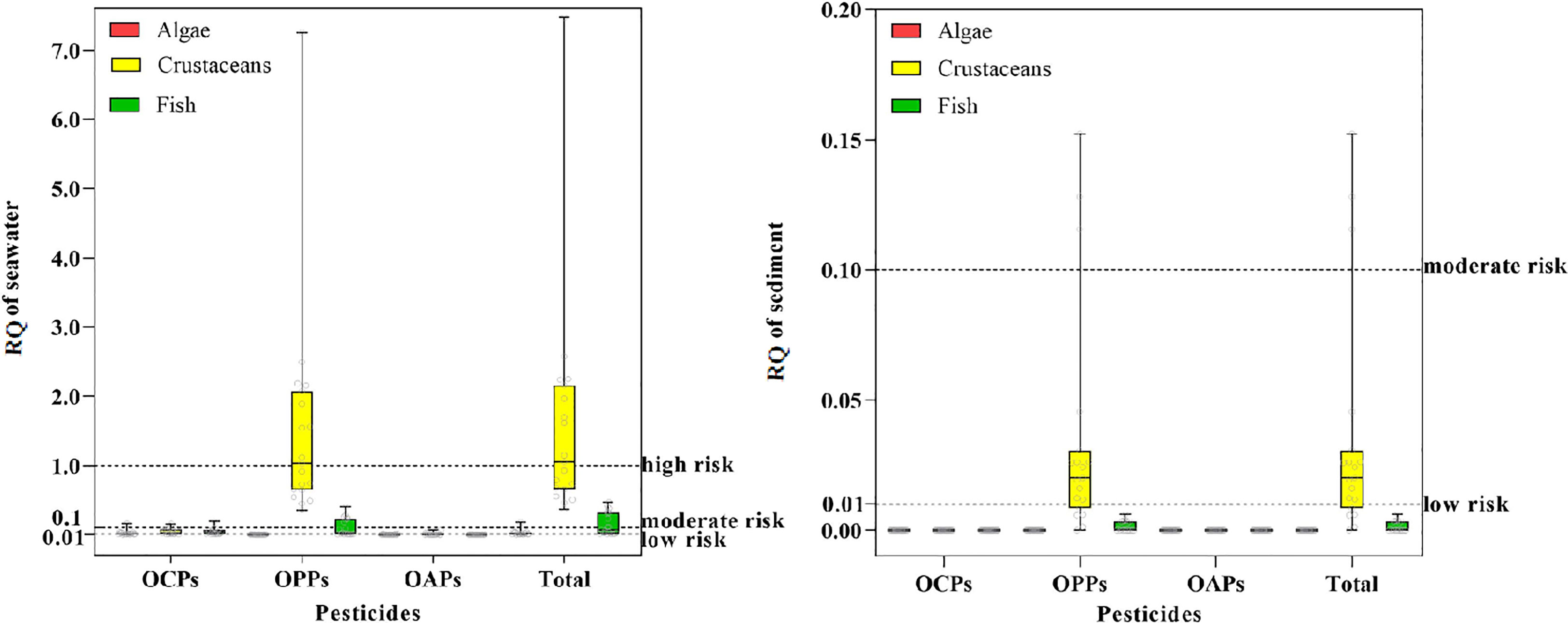
Figure 7 Ecological risks of algae, crustaceans and fish posed by of investigated pesticides in seawater and sediment. The bar means RQ value ranges in each site (n=19).
3.5.2 Health risk
The average daily dose of pesticides from the consumption of fish and shrimps was evaluated according to the method described in Section 2.7. For the median and high exposure scenario, the ADDs of selected pesticides were 0.32–3.11ng/kg/day and 5.52–54.1 ng/kg/day in fish and shrimp, respectively (Table 3). For each class of pesticides, the contribution of fish to the ADDs was above 90%. For both fish and shrimp, OCPs made the greatest contribution (>92%) to the ADDs of all selected pesticides, followed by OPPs. The total HQs were lower than the risk threshold for both the median (1.23×10-3–1.21×10-2) and high exposure scenarios (2.21×10-2–0.12), which indicated that the health risk of selected pesticides to humans in the Beibu Gulf was acceptable (Table 3). Therefore, we considered that the pesticides exposure posed little health risk for humans in the Beibu Gulf. Nevertheless, the HQ value of OCPs contributed the highest among all three groups of pesticides (>98%), which resulted from their high concentration and low RfD. Therefore, the OCPs in the Beibu Gulf should be paid special concern, especially considering that the Beibu Gulf is an important fishing ground and mariculture zone in China.
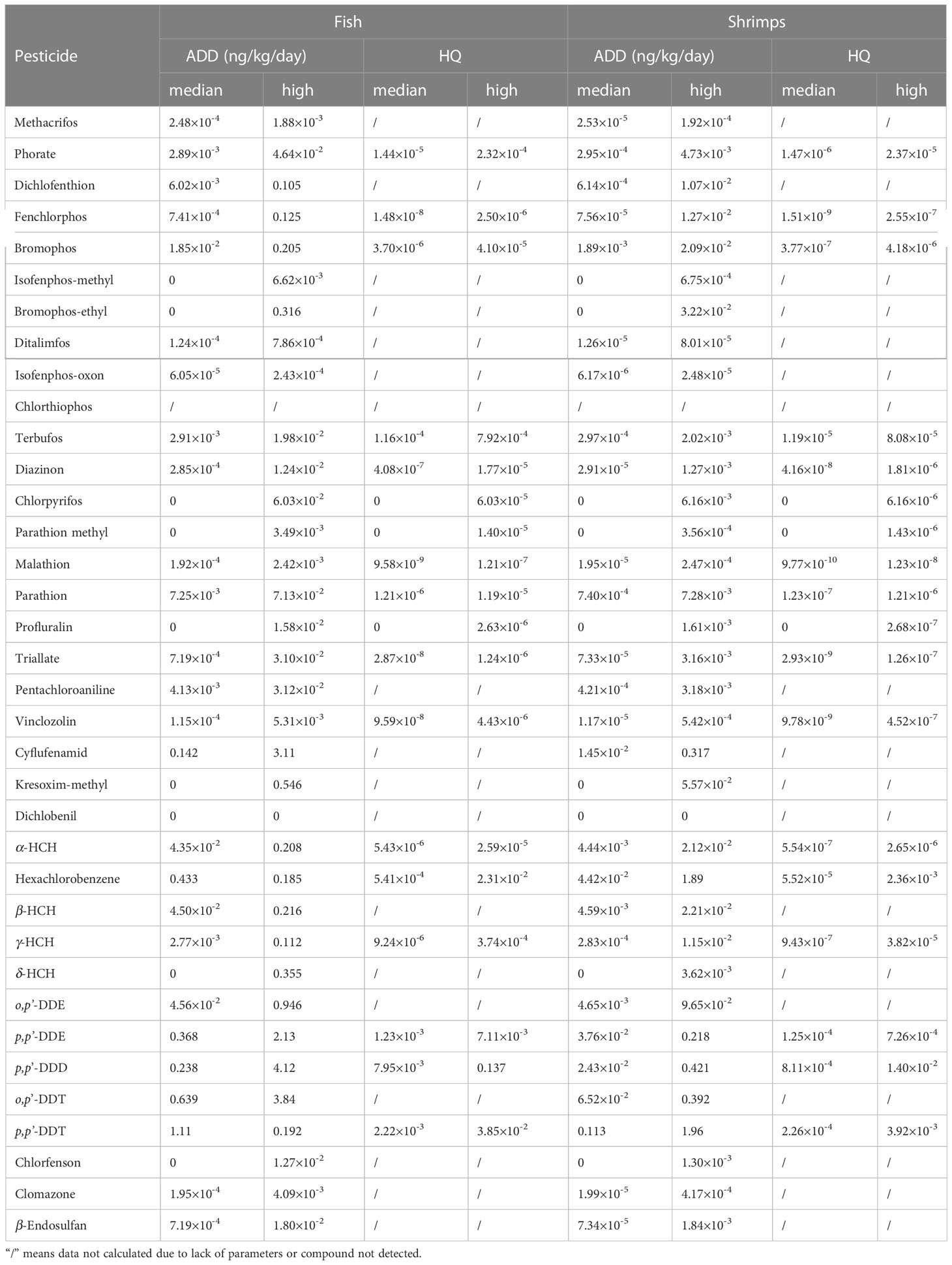
Table 3 The average daily dose of pesticides and health risks from the consumption of fish and shrimps.
4 Conclusion
In this study, the occurrence and distribution of 36 pesticides including 14 OCPs, 16 OPPs and 6 OAPs, were investigated in seawater and sediment in Beibu Gulf, a typical subtropical agricultural and mariculture zone. Overall, most pesticides were widely detected in this region with concentrations ranged from 0.36 to 21.07 ng/L in seawater and from 0.02 to 9.73 ng/g dw in sediment. Human activities (agricultural and maricultural activities) and environmental factors (oils and TOC contains) would influence the distribution of pesticides in marine ecosystems. A preliminary risk assessment indicated that OPPs in the water pose high risk to aquatic organisms especially to crustaceans. It should be noted that due to the lack of actual toxicity data for marine organisms, the results of some pesticides assessment need further investigate. According to the results of health risks proposed by the major aquatic products in Beibu Gulf (fish and shrimp), the selected pesticides pose no health risk to humans.
Data availability statement
The original contributions presented in the study are included in the article/Supplementary Material. Further inquiries can be directed to the corresponding authors.
Author contributions
LZ: Conceptualization, methodology, writing - original draft, writing - review & editing. JM: Methodology, investigation, writing. PL: Methodology, investigation, writing. AQ: writing, review, data processing & editing. HJ: Conceptualization, Methodology, writing - review & editing. RJ: Methodology, Data processing. ZZ: data processing, writing. CY: Methodology, data processing. MC: Conceptualization, Methodology, writing - review & editing. All authors contributed to the article and approved the submitted version.
Funding
This work was financially supported by the Guangxi Natural Science Foundation [grant number 2022GXNSFBA035575], Key Laboratory of Marine Ecological Monitoring and Restoration Technologies opening fund project (No. MEMRT202107), Guangxi Science and Technology Base and Talent Special Projects (Grant No. GuikeAD22035960), Guangxi key research and development project (Grant No. 2021AB34027), Science and Technology Planning Project of Beihai, Guang Xi, China (No. 202082042).
Acknowledgments
We thank all the crews on the R/V Yueke 1 and R/V Haike 68 for their assistance with the sampling during the cruises in 2021.
Conflict of interest
The authors declare that the research was conducted in the absence of any commercial or financial relationships that could be construed as a potential conflict of interest.
Publisher’s note
All claims expressed in this article are solely those of the authors and do not necessarily represent those of their affiliated organizations, or those of the publisher, the editors and the reviewers. Any product that may be evaluated in this article, or claim that may be made by its manufacturer, is not guaranteed or endorsed by the publisher.
Supplementary material
The Supplementary Material for this article can be found online at: https://www.frontiersin.org/articles/10.3389/fmars.2023.1167712/full#supplementary-material
References
Antić N., Radišić M., Radović T., Vasiljević T., Grujić S., Petković A., et al. (2015). Pesticide residues in the Danube river basin in Serbia – a survey during 2009–2011. Clean (Weinh.) 43, 197–204. doi: 10.1002/clen.201200360
Arellano-Aguilar O., Betancourt-Lozano M., Aguilar-Zárate G., Ponce de Leon-Hill C. (2017). Agrochemical loading in drains and rivers and its connection with pollution in coastal lagoons of the Mexican pacific. Environ. Monit. Assess. 189, 270. doi: 10.1007/s10661-017-5981-8
Arnot J. A., Gobas F. A. (2006). A review of bioconcentration factor (BCF) and bioaccumulation factor (BAF) assessments for organic chemicals in aquatic organisms. Environ. Rev. 14, 257–297. doi: 10.1139/a06-005
Babu V., Unnikrishnan P., Anu G., Nair S. M. (2011). Distribution of organophosphorus pesticides in the bed sediments of a backwater system located in an agricultural watershed: influence of seasonal intrusion of seawater. Arch. Environ. Contam. Toxicol. 60, 597–609. doi: 10.1007/s00244-010-9569-3
Baqar M., Sadef Y., Ahmad S. R., Mahmood A., Li J., Zhang G. (2018). Organochlorine pesticides across the tributaries of river ravi, Pakistan: Human health risk assessment through dermal exposure, ecological risks, source fingerprints and spatio-temporal distribution. Sci. Total Environ. 618, 291–305. doi: 10.1016/j.scitotenv.2017.10.234
Ccanccapa A., Masiá A., Andreu V., Picó Y. (2016). Spatio-temporal patterns of pesticide residues in the turia and júcar rivers (Spain). Sci. Total Environ. 540, 200–210. doi: 10.1016/j.scitotenv.2015.06.063
Chen M., Gan Z., Qu B., Chen S., Dai Y., Bao X. (2019). Temporal and seasonal variation and ecological risk evaluation of flame retardants in seawater and sediments from bohai bay near tianjin, China during 2014 to 2017. Mar. pollut. Bull. 146, 874–883. doi: 10.1016/j.marpolbul.2019.07.049
Chen Z., Xu S., Qiu Y., Lin Z., Jia X. (2009). Modeling the effects of fishery management and marine protected areas on the beibu gulf using spatial ecosystem simulation. Fish. Res. 100 (3), 222–229. doi: 10.1016/j.fishres.2009.08.001
Doong R. A., Peng C. K., Sun Y. C., Liao P. L. (2002). Composition and distribution of organochlorine pesticide residues in surface sediments from the Wu-shi river estuary, Taiwan. Mar. pollut. Bull. 45, 246–253. doi: 10.1016/S0025-326X(02)00102-9
Erkmen B., Yerli S., Erkakan F., Kolankaya D. (2013). Persistent organochlorine pesticide residues in water and sediment samples from lake manyas, Turkey. J. Environ. Biol. 34, 171–176. doi: 10.5539/enrr.v5n3p28
European Commision (2011). Technical guidance for deriving environmental quality standards, guidance document no. 27, common implementation strategy for the water framework directive, (2000/60/EC) technical report-2011-055. Brussels, Belgium: European Communities.
Fadaei A., Dehghani M. H., Nasseri S., Mahvi A. H., Rastkari N., Shayeghi M. (2012). Organophosphorous pesticides in surface water of Iran. B. Environ. Contam. Tox. 88, 867–869. doi: 10.1007/s00128-012-0568-0
Gandla V., Chiluka M., Gupta H., Sinha S. N., Chakraborty P. (2023). Sediment-water partitioning and risk assessment of organochlorine pesticides along the urban, peri-urban and rural transects of Krishna river basin, peninsular India. Sci. Total Environ. 874, 162360. doi: 10.1016/j.scitotenv.2023.162360
Gao J., Wu G., Ya H. (2017). Review of the circulation in the beibu gulf, south China Sea. Cont. Shelf Res. 138, 106–119. doi: 10.1016/j.csr.2017.02.009
Grung M., Lin Y., Zhang H., Steen A. O., Huang J., Zhang G., et al. (2015). Pesticide levels and environmental risk in aquatic environments in China — a review. Environ. Int. 81, 87–97. doi: 10.1016/j.envint.2015.04.013
Guo J. Y., Wu F. C., Shen R. L., Zeng E. Y. (2010). Dietary intake and potential health risk of DDTs and PBDEs via seafood consumption in south China. Ecotoxicol. Environ. Saf. 73, 1812–1819. doi: 10.1016/j.ecoenv.2010.08.009
Girones L., Oliva A. L., Marcovecchio J. E., and Arias H. A (2020). Spatial distribution and ecological risk assessment of residual organochlorine pesticides (OCPs) in South American marine environments[J]. Curr. Envir. Health. Rpt. 7, 147–160. doi: 10.1007/s40572-020-00272-7
Kaiser D., Schulz-Bull D. E., Waniek J. J. (2016). Profiles and inventories of organic pollutants in sediments from the central beibu gulf and its coastal mangroves. Chemosphere 153, 39–47. doi: 10.1016/j.chemosphere.2016.03.041
Laetz C. A., Baldwin D. H., Collier T. K., Hebert V., Stark J. D., Scholz N. L. (2009). The synergistic toxicity of pesticide mixtures: implications for risk assessment and the conservation of endangered pacific salmon. Environ. Health Perspect. 117, 348–353. doi: 10.1289/ehp.0800096
Lisker E. B., Ensminger M. P., Gill S. L., Goh K. S. (2011). Detections of eleven organophosphorus insecticides and one herbicide threatening pacific salmonids, oncorhynchus spp., in California 1991–2010. B. Environ. Contam. Tox. 87, 355–360. doi: 10.1007/s00128-011-0351-7
Luo X. J., Liu J., Luo Y., Zhang X. L., Wu J. P., Lin Z., et al. (2009). Polybrominated diphenyl ethers (PBDEs) in free-range domestic fowl from an e-waste recycling site in south China: levels, profile and human dietary exposure. Environ. Int. 35, 253–258. doi: 10.1016/j.envint.2008.06.007
Masiá A., Campo J., Vázquez-Roig P., Blasco C., Picó Y. (2013). Screening of currently used pesticides in water, sediments and biota of the guadalquivir river basin (Spain). J. Hazard. Mater. 263, 95–104. doi: 10.1016/j.jhazmat.2013.09.035
Montuori P., Aurino S., Garzonio F., Sarnacchiaro P., Polichetti S., Nardone A., et al. (2016). Estimates of Tiber river organophosphate pesticide loads to the tyrrhenian Sea and ecological risk. Sci. Total Environ. 559, 218–231. doi: 10.1016/j.scitotenv.2016.03.156
Navarrete I. A., Tee K. A. M., Unson J. R. S., Hallare A. V. (2018). Organochlorine pesticide residues in surface water and groundwater along pampanga river, Philippines. Environ. Monit. Assess. 190, 289. doi: 10.1007/s10661-018-6680-9
Olisah C., Rubidge G., Human L. R. D., Janine B. A. (2022). Organophosphate pesticides in south African eutrophic estuaries: Spatial distribution, seasonal variation, and ecological risk assessment. Environ. pollut. 306, 119446. doi: 10.1016/j.envpol.2022.119446
Peng S. Y., Kong D. M., Li L. T., Zou C. L., Chen F. J., Li M. J., et al. (2020). Distribution and sources of DDT and its metabolites in porewater and sediment from a typical tropical bay in the south China Sea. Environ. pollut. 267, 115492. doi: 10.1016/j.envpol.2020.115492
Pirsaheb M., Hossini H., Asadi F., Janjani H. (2017). A systematic review on organochlorine and organophosphorus pesticides content in water resources. Toxin Rev. 36, 210–221. doi: 10.1080/15569543.2016.1269810
Qiu Y., Xiao X., Cheng H., Zhou Z., Sheng G. (2009). Influence of environmental factors on pesticide adsorption by black carbon: pH and model dissolved organic matter. Environ. Sci. Technol. 43, 4973–4978. doi: 10.1021/es900573d
Rico A., Satapornvanit K., Haque M. M., Min J., Nguyen P. T., Telfer T. C., et al. (2012). Use of chemicals and biological products in Asian aquaculture and their potential environmental risks: a critical review. Rev. Aquac. 4, 75–93. doi: 10.1111/j.1753-5131.2012.01062.x
Rockne K. J., Shor L. M., Young L. Y., Taghon G. L., Kosson D. S. (2002). Distributed sequestration and release of PAHs in weathered sediment: the role of sediment structure and organic carbon properties. Environ. Sci. Technol. 36, 2636–2644. doi: 10.1021/es015652h
Sapkota A., Sapkota A. R., Kucharski M., Burke J., McKenzie S., Walker P., et al. (2008). Aquaculture practices and potential human health risks: current knowledge and future priorities. Environ. Int. 34, 1215–1226. doi: 10.1016/j.envint.2008.04.009
Shan G. Q., Qian X., Chen X., Feng X. M., Cai M. H., Yang L., et al. (2021). Legacy and emerging per- and poly-fluoroalkyl substances in surface seawater from northwestern pacific to southern ocean: Evidences of current and historical release. J. Hazard. Mater. 411, 125049. doi: 10.1016/j.jhazmat.2021.125049
Tang D. H., Liu X. J., He H. J., Cui Z. N., Gan H. Y., Xia Z. (2020). Distribution, sources and ecological risks of organochlorine compounds (DDTs, HCHs and PCBs) in surface sediments from the pearl river estuary, China. Mar. pollut. Bull. 152, 110942. doi: 10.1016/j.marpolbul.2020.110942
The Oceanic Administration of Guangxi (2017). The 13th five-year, (2016-2020) plan for the development of marine fishery in guangxi province, China (In Chinese). Guangxi Fish. Sci. Technol. 1), 3–20.
The Statistical Bureau of Guangxi (2020). http://tjj.gxzf.gov.cn//tjsj/tjnj/material/tjnj20200415/2020/zk/indexch.htm
Ullah R., Asghar R., Baqar M., Mahmood A., Ali S. N., Sohail M., et al. (2019). Assessment of organochlorine pesticides in the Himalayan riverine ecosystems from Pakistan using passive sampling techniques. Environ. Sci. pollut. Res. 26, 6023–6037. doi: 10.1007/s11356-018-3987-6
Van Dyk J. S., Pletschke B. (2011). Review on the use of enzymes for the detection of organochlorine, organophosphate and carbamate pesticides in the environment. Chemosphere 82, 291–307. doi: 10.1016/j.chemosphere.2010.10.033
Wang C., Feng L., Thakuri B., Amit C. (2022a). Ecological risk assessment of organochlorine pesticide mixture in south China Sea and East China Sea under the effects of seasonal changes and phase-partitioning. Mar. pollut. Bull. 185, 114329. doi: 10.1016/j.marpolbul.2022.114329
Wang S. Q., Wu L. B., Wang Z. J., Du H. H., Zhu J. C., Li Y. Y., et al. (2023). Occurrence, vertical distribution and transport of organic amine pesticides in the seawater from the East China Sea and the south China Sea. Sci. Total Environ. 860, 160487. doi: 10.1016/j.scitotenv.2022.160487
Wang L., Zheng M. G., Xu H. Y., Hua Y., Liu A. F., Li Y., et al. (2022b). Fate and ecological risks of current-use pesticides in seawater and sediment of the yellow Sea and East China Sea. Environ. Res. 207, 112673. doi: 10.1016/j.envres.2021.112673
Wang T. L., Zhong M. M., Lu M. L., Xu D. J., Xue Y. G., Huang J., et al. (2021). Occurrence, spatiotemporal distribution, and risk assessment of current-use pesticides in surface water: A case study near taihu lake, China. Sci. Total Environ. 782, 146826. doi: 10.1016/j.scitotenv.2021.146826
Wee S. Y., Aris A. Z. (2017). Ecological risk estimation of organophosphorus pesticides in riverine ecosystems. Chemosphere 188, 575–581. doi: 10.1016/j.chemosphere.2017.09.035
Xiao K., Zhu N., Lu Z., Zheng H., Cui C., Gao Y., et al. (2021). Distribution of eight organophosphorus pesticides and their oxides in surface water of the East China Sea based on high volume solid phase extraction method. Environ. pollut. 279, 116886. doi: 10.1016/j.envpol.2021.116886
Xu Y. Y., Wang Y. H., Li J., Liu X., Zhang R. J., Guo S. J., et al. (2013). Distributions, possible sources and biological risk of DDTs, HCHs and chlordanes in sediments of beibu gulf and its tributary rivers, China. Mar. pollut. Bull. 76, 52–60. doi: 10.1016/j.marpolbul.2013.09.032
Yang H. Y. (2011). Study on organochlorine pesticides and polychlorinated biphenyls in Yangtze river and adjacent sea [D] (Zhejiang University of Technology).
Yang H. Y., Zhou S. S., Li W. D., Liu Q., Tu Y. J. (2015). Residues, sources and potential biological risk of organochlorine pesticides in surface sediments of qiandao lake, China. Bull. Environ. Contam. Toxicol. 95, 521–524. doi: 10.1007/s00128-015-1553-1
Zenati B., Inal A., Mesbaiah F. Z., Kourdali S., Bachouche S., Pinho J. (2023). Pollutant load discharge from a southwestern Mediterranean river (Mazafran river, Algeria) and its impact on the coastal environment. Arab. J. Geosci. 16, 146. doi: 10.1007/s12517-023-11260-0
Zhang L., Lu L., Zhu W. J., Yang B., Lu D. L., Dan S. F., et al. (2021a). Organophosphorus flame retardants (OPFRs) in the seawater and sediments of the qinzhou bay, northern beibu gulf: Occurrence, distribution, and ecological risks. Mar. pollut. Bull. 168, 112368. doi: 10.1016/j.marpolbul.2021.112368
Zhang R. H., Du J., Dong X. B., Huang Y., Xie H. J., Chen J., et al. (2021b). Occurrence and ecological risks of 156 pharmaceuticals and 296 pesticides in seawater from mariculture areas of northeast China. Sci. Total Environ. 792, 148375. doi: 10.1016/j.scitotenv.2021.148375
Zhang S. W., Yang C., Liu M. Y., Zhao W. Y., Li Y. X., Meng X. Z., et al. (2021c). Occurrence of organophosphate esters in surface water and sediment in drinking water source of xiangjiang river, China. Sci. Total Environ. 781, 146734. doi: 10.1016/j.scitotenv.2021.146734
Zhang R. J., Yu K. F., Li A., Zeng W. B., Lin T., Wang Y. H. (2020a). Occurrence, phase distribution, and bioaccumulation of organophosphate esters (OPEs) in mariculture farms of the beibu gulf, China: A health risk assessment through seafood consumption. Environ. pollut. 263, 114426. doi: 10.1016/j.envpol.2020.114426
Zhang X., Zhang X. M., Zhang Z. F., Yang P. F., Li Y. F., Cai M. H., et al. (2022). Pesticides in the atmosphere and seawater in a transect study from the Western pacific to the southern ocean: The importance of continental discharges and air-seawater exchange. Water Res. 217, 118439. doi: 10.1016/j.watres.2022.118439
Zhang S. W., Zhu N. Z., Zheng H. Y., Gao Y., Du H. N., Cai M. H., et al. (2020b). Occurrence of seventy-nine SVOCs in tap water of china based on high throughput organic analysis testing combined with high volume solid phase extraction. Chemosphere 256, 127136. doi: 10.1016/j.chemosphere.2020.127136
Keywords: seawater, surface sediment, organic amine pesticides, organophosphate pesticides, organochlorine pesticides
Citation: Zhang L, Ma J, Liu P, Qi A, Jin H, Jia R, Zheng Z, Yan C and Cai M (2023) Contamination characteristics, spatial distribution and ecological-health risk assessment of legacy and current-use pesticides: a case study in the Beibu Gulf. Front. Mar. Sci. 10:1167712. doi: 10.3389/fmars.2023.1167712
Received: 16 February 2023; Accepted: 30 March 2023;
Published: 18 April 2023.
Edited by:
Víctor M. León, Spanish Institute of Oceanography, SpainReviewed by:
Marina G. Pintado-Herrera, University of Cádiz, SpainCatarina Da Rocha Cruzeiro, Helmholtz Association of German Research Centres (HZ), Germany
Copyright © 2023 Zhang, Ma, Liu, Qi, Jin, Jia, Zheng, Yan and Cai. This is an open-access article distributed under the terms of the Creative Commons Attribution License (CC BY). The use, distribution or reproduction in other forums is permitted, provided the original author(s) and the copyright owner(s) are credited and that the original publication in this journal is cited, in accordance with accepted academic practice. No use, distribution or reproduction is permitted which does not comply with these terms.
*Correspondence: Li Zhang, emhhbmdsaUA0aW8ub3JnLmNu; Minghong Cai, Y2FpbWluZ2hvbmdAcHJpYy5vcmcuY24=
 Li Zhang
Li Zhang Jiaxin Ma1
Jiaxin Ma1 Haiyan Jin
Haiyan Jin Renming Jia
Renming Jia Cheng Yan
Cheng Yan Minghong Cai
Minghong Cai